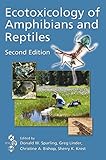Ecotoxicology of amphibians and reptiles / edited by Donald W. Sparling, ... [et al.]
Sparling, Donald W [editor] | Linder, Greg [editor/a] | Bishop, Christine A [editor/a] | Krest, Sherry K [editor/a].
Tipo de material: Libro
impreso(a)
Editor: Boca Raton, Florida: Society of Environmental Toxicology and Chemistry CRC Press, c2010Edición: Second edition.Descripción: xxv, 916 páginas ; 26 centímetros.ISBN: 1420064169; 9781420064162.Tema(s): Anfibios
Libro
impreso(a)
Editor: Boca Raton, Florida: Society of Environmental Toxicology and Chemistry CRC Press, c2010Edición: Second edition.Descripción: xxv, 916 páginas ; 26 centímetros.ISBN: 1420064169; 9781420064162.Tema(s): Anfibios| Tipo de ítem | Biblioteca actual | Colección | Signatura | Estado | Fecha de vencimiento | Código de barras |
|---|---|---|---|---|---|---|
| Libros |
Biblioteca Chetumal
Texto en configuración de biblioteca Chetumal |
Acervo General | 597.81727 E2 | Disponible | ECO030008393 |
Incluye bibliografía e índice: páginas 905-916
List of figures.. List of Tables.. About the Editors.. List of Contributors.. Acknowledgements.. Preface for Second Edition.. Preface form the First Edition.. Chapter 1 Recent Advancements in Amphibian and Reptile Ecotoxicology.. Chapter 2 Declines and the Global Status of Amphibians.. Chapter 3 The Global Status of Reptiles and Causes of Their Decline.. Chapter 4 Ecotoxicology of Amphibians and Reptiles in a Nutshell.. Chapter 5 Physiological Ecology of Amphibians and Reptiles: Natural History and Life History Attributes Framing Chemical Exposure in the Field.. Chapter 6 Effects of Current Use Pesticides on Amphibians.. Chapter 7 Ecotoxicology of Pesticides in Reptiles.. Chapter 8 Atrazine in the Environment and Its Implications for Amphibians and Reptiles.. Chapter 9 Ecotoxicology of Organic Contaminants to Amphibians.. Chapter 10 Organic Contaminants in Reptiles.. Chapter 11 Interdisciplinary and Hierarchical Approaches for Studying the Effects of Metals and Metalloids on Amphibians.. Chapter 12 The Ecotoxicology of Metals in Reptiles.. Chapter 13 Solar UV Radiation and Amphibians: Factors Mitigating Injury.. Chapter 14 Multiple Stressors and Indirect Food Web Effects of Contaminants on Herptofauna.. Chapter 15 Emerging Contaminants and Their Potential Effects on Amphibians and Reptiles.. Chapter 16 A Decade of Deformities: Advances in Our Understanding of Amphibian Malformations and Their Implications.. Chapter 17 Population Estimation Methods for Amphibians and Reptiles.. Chapter 18 Epilogue: Ecotoxicology of Amphibians and Reptiles - Where Should Be We Going and How Do We Get There?.. Appendix: Metal Contamination in Reptiles: An Appendix of Data Compiled from the Existing Literature.. Index
Building on the success of its popular predecessor, the second edition of Ecotoxicology of Amphibians and Reptiles presents newly available findings on the species that are important environmental indicators. This new edition covers nearly twice as many topics as the first, including recent developments in the ecotoxicology of amphibians and reptiles, the current status of these animals, and intrinsic factors that affect their susceptibility to contaminants. The book also provides the latest information on specific groups of contaminants and their effects and body burdens in herpetafauna. After a review of how contaminants interact with other ecological factors, the text explores concerns for the future. New in the second edition: • New research on the effects of pesticides, heavy metals, endocrine disrupting chemicals, and UVB. • Increased focus on the effects of contaminants rather than merely reporting residue information. • A synthesis of information on atrazine and its effects on gonads at low concentrations. • Coverage of the potentially alarming new cadre of chemicals that have recently or are about to come on the market for which there is very little or no information. • Important advances in surveying and monitoring. One of the major factors behind the writing of the first edition was the worldwide phenomenon of declining amphibian populations. Although this decline has not abated, the breadth of research into its causes has expanded significantly. With chapter contributors carefully selected by the team of editors as leaders in their fields, this book provides an authoritative compendium of the most recent information on effects and residues coupled with a syntheses of what these numbers mean to science and policy. eng
